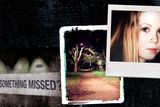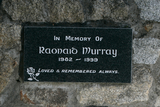Close to home: The long hunt for Raonaid's mystery killer
Twenty years after the violent death of Dublin teenager Raonaid Murray, there's still no consensus as to who might have killed her, writes John Meagher


Glenageary is the embodiment of that loaded phrase 'leafy south Dublin'. One needs especially deep pockets to afford a home in this suburb next to Dún Laoghaire.
The imposing Victorian houses on Silchester Road speak of old money, but the newer homes fall into 'des res' real estate-speak, too.
In the heart of Glenageary, a laneway connects Silchester Road and Silchester Crescent. Known locally as 'the Cut', it's about 100m long, with grassy verges on either side and plenty of mature trees. At the Crescent end, a high wall borders Glenageary Lawn Tennis Club and the happy sounds of players enjoying the spring sunshine could be heard this week.
There's a memorial plaque on the wall, too, and passers-by who are not familiar with the area or the name Raonaid Murray might assume she was a 17-year-old who died in tragic, but not sinister, circumstances.
Raonaid Murray
In truth, though, there are likely to be few Irish people - certainly those above the age of 35 - who do not know her name and the horrific death she suffered.
On the warm late summer's night of Saturday, September 4, 1999, Raonaid had finished her part-time job at a fashion boutique in the Dún Laoghaire Shopping Centre and went across the road to the popular Scotts pub where she socialised with a friend.
At about 11.30pm, she decided to go to her family home at Silchester Park - a 15-minute walk away - get changed and then walk back to meet the same friend at Paparazzi's nightclub in Dún Laoghaire. She never returned.
Raonaid was attacked as she walked down 'the Cut' and stabbed more than 30 times. She managed to crawl along the length of the laneway before collapsing and dying at the spot where the plaque is in her honour is today. She was found by her older sister, Sarah, who was out walking with three friends. She had not been robbed or sexually assaulted.
Despite the fact that houses overlook the laneway and the area is quite built up, nobody came forward to say they saw the attack or the perpetrator.
Two decades on and the killer has never been apprehended, and the murder weapon - thought to be a kitchen knife - has not been found.
Emotional appeal: the parents of Raonaid Murray
The hunt for Raonaid's killer would lead to the biggest homicide investigation in the history of the state. More than 3,500 statements were taken. Thousands of households had visits from gardaí and they tried to contact anyone who had been socialising in the Dún Laoghaire, Glenageary and Glasthule areas that night. At one stage, gardaí had 200 suspects - or 'persons of interest' - on their books and, of those, 22 people were given 'red alert' status.
While the investigation remains live at both Dún Laoghaire Garda Station and the Serious Crime Review team, there have been no official police appeals since September 2016 and since then, it is thought there have been no new leads.
The possibility that the perpetrator was female has never been ruled out. Many of the stab wounds were shallow, some barely denting Raonaid's light clothing, leading investigators to conclude that the killer may not have been physically strong. Furthermore, female DNA was found on her body, but that could have been a consequence of working in a clothes shop in proximity to women.
Boasted of murder
There has been much speculation over the years, but more high-profile suspects have been ruled out. They include Somali immigrant Farah Swaleh Noor, who was killed in 2005 by the so-called Scissor Sisters, Linda and Charlotte Mulhall: Noor had boasted of murdering Raonaid to the Mulhalls, but he was a fantasist and gardaí are satisfied he was not responsible.
Graham Dwyer has also been ruled out. The killer of Elaine O'Hara had a fixation with knives, and once sent her a text mentioning that Raonaid's killer had never been found, but he is not linked to Raonaid's death - which occurred 13 years before he murdered O'Hara in August 2012.
A local female, who had violent tendencies when she was younger, has also been taken off the list of suspects.
The funeral of Raonaid Murray at St Joseph's Church, Glasthule. Photo: Colin O'Riordan
Investigators who have worked on the case and criminologists who have analysed it have spoken to the media over the years about the killer's profile, but there's little consensus as to whether she knew her assailant or not. Years after retiring, detective Gerry O'Carroll, who worked on the case, wrote in his Herald column that "forensic profiling tells us that he would be a young man, in his mid to late twenties, single, living either alone or with his mother, a loner, possibly with a drug problem. He may also have been in psychiatric care on a number of occasions.
"There is no doubt that Raonaid's killer was a disturbed, dangerous psychopath and our fears at the time were that he would strike again."
UK criminologist Mike Berry agreed that he was a young man, but believed the perpetrator knew Raonaid. "I believe it is most likely that Raonaid's killer was aged between 17 and 25." He may have known or thought he knew Raonaid. He may have seen her somewhere and felt that he knew her."
A fresh insight has been provided to Review this week by one of the UK's leading criminologists, Dr Jane Monckton Smith. She is lecturing at the Garda College in Templemore this month and she believes it is highly unlikely that Raonaid was attacked by a stranger. "When it's a woman who is killed, most crimes of this nature are carried out by someone known to them," she says. "There's greater chance of a man being murdered by someone unknown to them."
She points out that it is common for female victims to be killed by someone they know in their own home. "But this is very close to her home and that raises suspicions that she knew this person. Statistically speaking, she would have known this person."
An eyewitness saw a young woman matching Raonaid's description arguing with a male on nearby Glenageary Road shortly before midnight. It's a route she would have almost certainly taken on the way home. Furthermore, residents in a garden close to the Cut heard a young woman shout out "go away", "leave me alone" and "f*** off" around that time.
"Those words suggest somebody that she didn't want to speak to or somebody who was bothering her," she says. "They could have been stalking her, which would mean that it was somebody she did know. My gut tells me she knew who it was, and those choice of words are critical."
The likelihood that Raonaid was killed by someone she knew is borne out by statistics for Irish homicide. According to Dr Orla Lynch, head of criminology at University College Cork: "A 2011 study [Lee-Gorman et al] that looked at the cases dealt with by the crime lab in Ireland found that in cases of homicide, the majority of the victims were men, the most common age group of victims was 20 to 29 years old, the majority of the suspects were men, the most common age of suspect was also 20 to 29 years old, and homicides are more likely to occur over the weekend period.
"Furthermore," she tells Review, "this research showed that you are more likely to be killed at or near your own home (and very likely to be killed in a residence), and in the majority of cases, the victim and the perpetrator were known to each other."
Dr Lynch also points to a 2007 Irish research study by Dr Enda Dooley which "estimated that in over 70pc of cases, the victim and perpetrator were known to each other… and in over 70pc of homicide cases in Ireland, the victim was killed in their own home."
Dr Monckton Smith believes the "unprofessional" nature of the killing indicates little prior planning. "Usually, in a planned attack, the person will go for somebody that they can overpower, somebody they can control, even if they are not very good at controlling them, but Raonaid was able to crawl along the laneway and able to crawl away from this person.
"And if there were only four potentially fatal injuries [out of 30-odd stab wounds], the killer may not have known for sure that she is dead, which is strange. And it's not logical to kill someone in a place as open as this where they could have easily been seen."
She says it is impossible to discount the possibility that the killer was female. "Statistically, it would be unusual [if the killer] was a woman, but it depends what the motivation is. In this case, the motivation for a stranger-killing just isn't there, so the motivation is probably something to do with her and the killer. And women hardly ever do stranger-killings. Somebody must know more than they're saying.
"The classic suspect in these types of cases is a boyfriend or somebody who was interested in her in that way, or somebody she had rejected, or if it was female, which would be unusual, but not unheard of, it could have been somebody who thought their boyfriend was interested in her. Those are crucial questions to ask when you're talking about the murder of a female. Nine times out of 10, that sort of detail is highly relevant."
Raonaid had a boyfriend at the time of her death - a young barman who worked at Scotts - but he was ruled out immediately when CCTV footage showed he had been working in the pub during the time of her death.
Twenty years on, and the mystery of Raonaid's murder continues to haunt Glenageary - and the country at large.
"Murders that are unsolved and murders that are assumed to be carried out by a stranger represent something larger than life, something truly monstrous," says Dr Orla Lynch.
"They are the social myths that sustain our fear of the unknown. They violate our belief in a just world - if someone can be killed by a stranger, through no fault of their own - the logical conclusion is that anyone could be at risk.
"The notion of the innocent victim is important here, too, as is the fact that she was a teenager and female… that she wasn't seen as playing any role in her own victimisation. That is something that resonates strongly with people."
Join the Irish Independent WhatsApp channel
Stay up to date with all the latest news
















